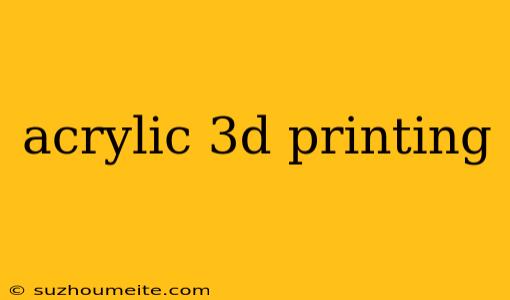Acrylic 3D Printing: A Comprehensive Guide
What is Acrylic 3D Printing?
Acrylic 3D printing is a type of additive manufacturing process that uses acrylic resin as the primary material. Acrylic resin is a type of plastic that is known for its transparency, durability, and versatility. In acrylic 3D printing, the resin is cured layer by layer using a light source, such as a laser or LED, to create a solid object.
How Does Acrylic 3D Printing Work?
The acrylic 3D printing process involves several steps:
1. Design
The first step in acrylic 3D printing is to design the object using computer-aided design (CAD) software. The design is then sliced into thin layers, which are used as a guide for the printing process.
2. Printing
The acrylic resin is poured into a vat, and a build platform is submerged into the resin. A light source is then used to cure the resin layer by layer, bonding each layer to the previous one. The build platform is raised after each layer is cured, and the process is repeated until the object is complete.
3. Curing
Once the printing process is complete, the object is removed from the vat and washed to remove any excess resin. The object is then cured in a UV chamber to fully harden the resin.
Advantages of Acrylic 3D Printing
Acrylic 3D printing offers several advantages over traditional manufacturing methods, including:
High Accuracy
Acrylic 3D printing allows for high accuracy and precision, making it ideal for applications where exact replication is crucial.
Flexibility
Acrylic resin can be formulated to have a range of properties, from flexible to rigid, making it suitable for a variety of applications.
Cost-Effective
Acrylic 3D printing is a cost-effective method of producing complex objects, especially for small batches or one-off productions.
Applications of Acrylic 3D Printing
Acrylic 3D printing has a wide range of applications, including:
Prototyping
Acrylic 3D printing is ideal for rapid prototyping, allowing designers to quickly test and refine their designs.
Model Making
Acrylic 3D printing is used in model making, such as architectural models, medical models, and artistic models.
Production Parts
Acrylic 3D printing can be used to produce functional parts, such as custom fixtures, inserts, and components.
Challenges and Limitations
While acrylic 3D printing offers many benefits, there are also some challenges and limitations to consider:
Material Properties
Acrylic resin can be prone to yellowing or cracking over time, and its mechanical properties may not be suitable for all applications.
Post-Processing
Acrylic 3D printing often requires additional post-processing steps, such as sanding and painting, to achieve the desired finish.
Scalability
Acrylic 3D printing can be slow and labor-intensive, making it less suitable for large-scale production.
Conclusion
Acrylic 3D printing is a versatile and cost-effective method of producing complex objects with high accuracy and precision. While it offers many benefits, it also has some limitations and challenges that need to be considered. As the technology continues to evolve, we can expect to see even more innovative applications of acrylic 3D printing in various industries.
